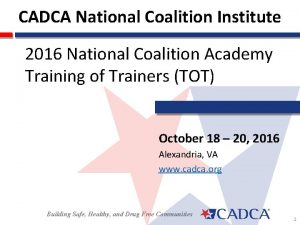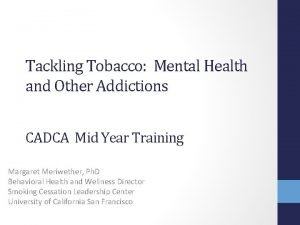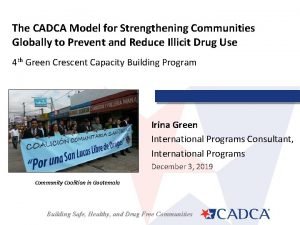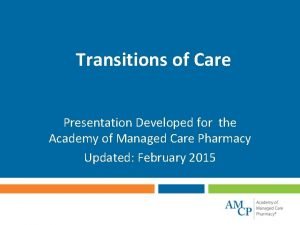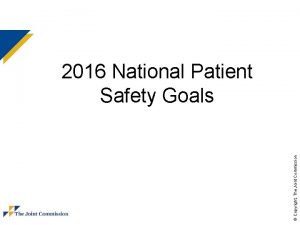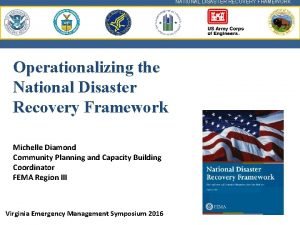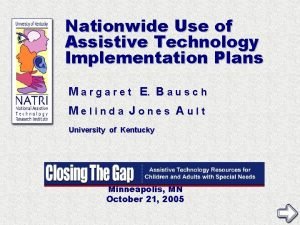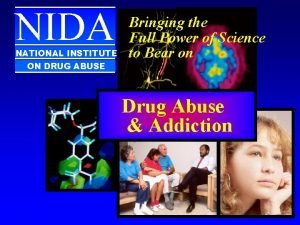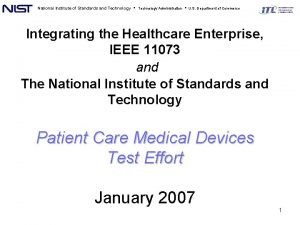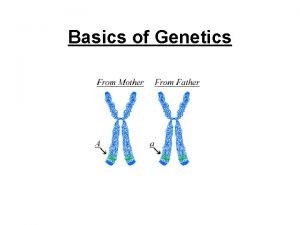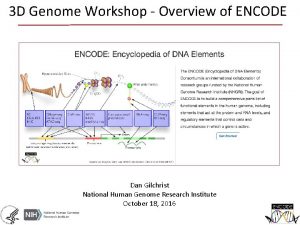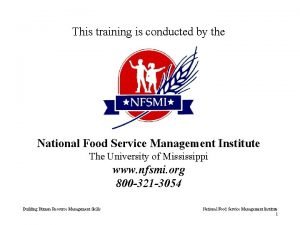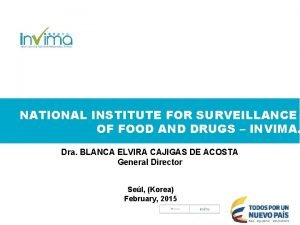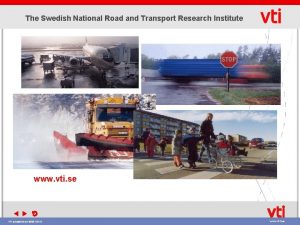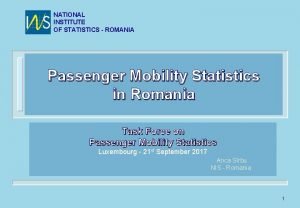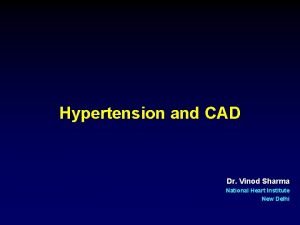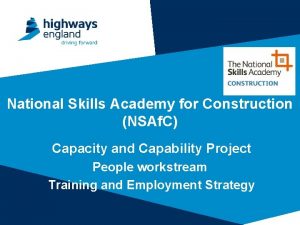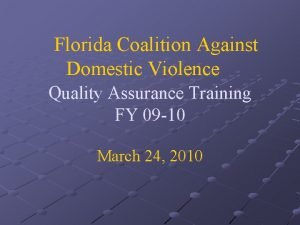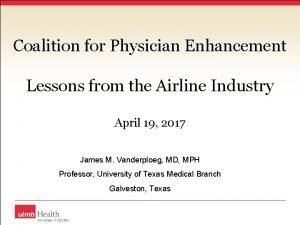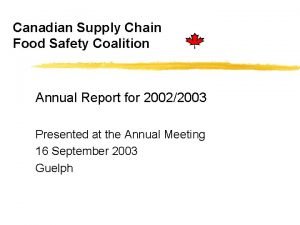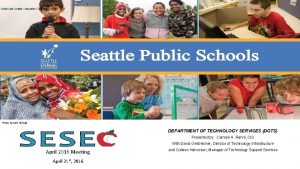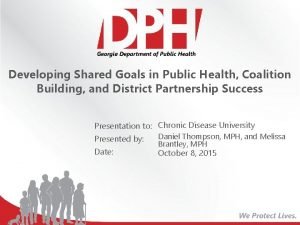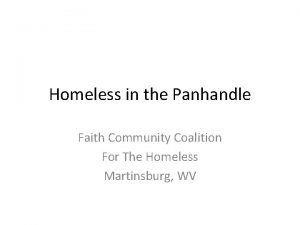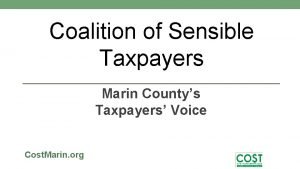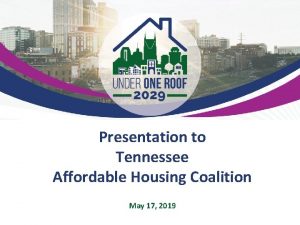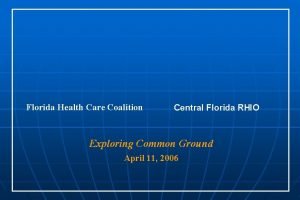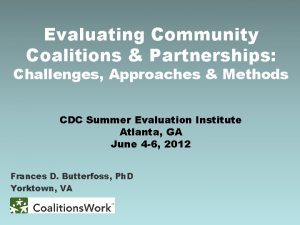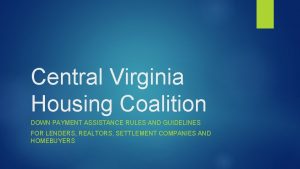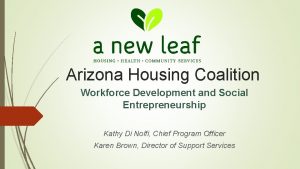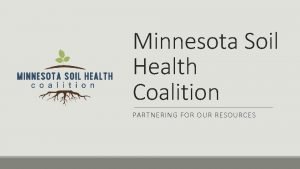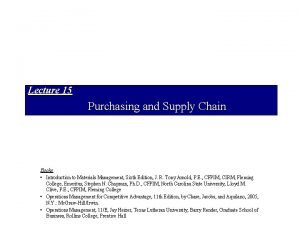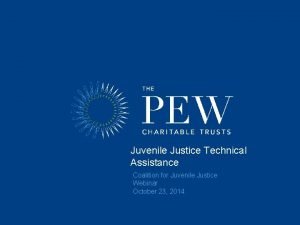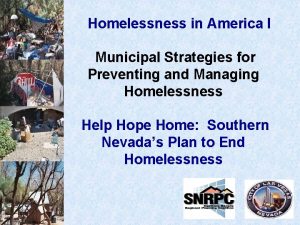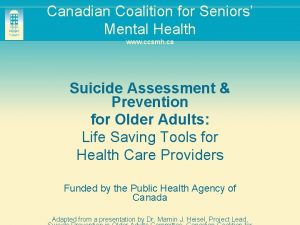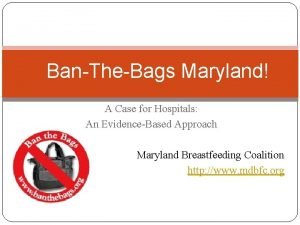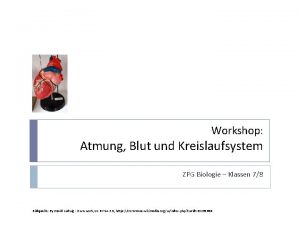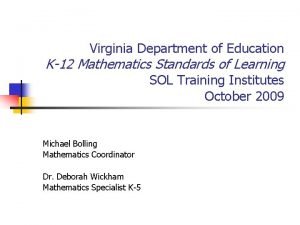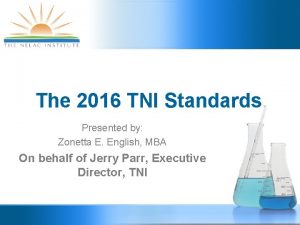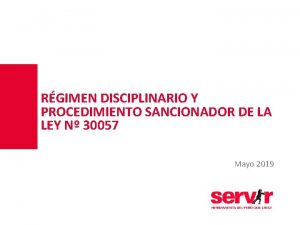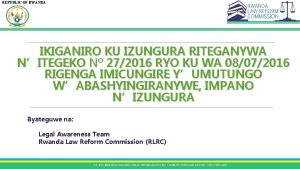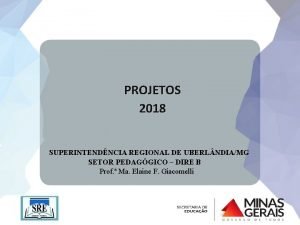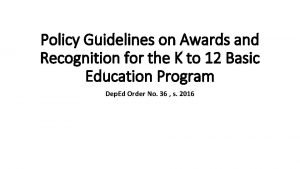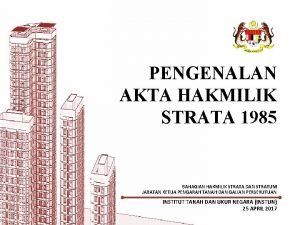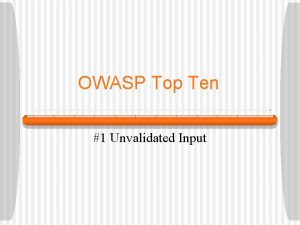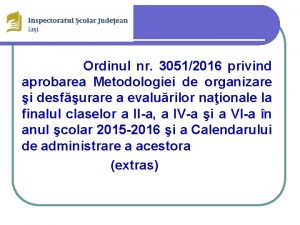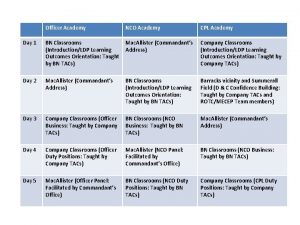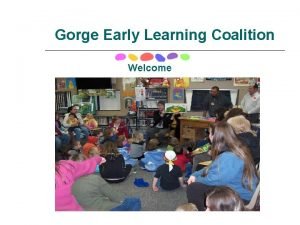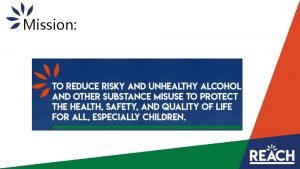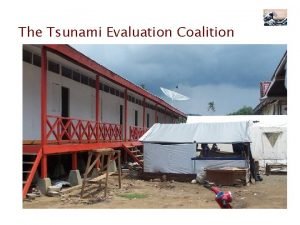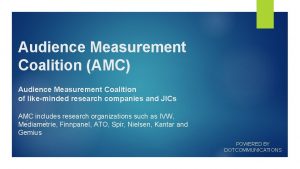CADCA National Coalition Institute 2016 National Coalition Academy












































































































- Slides: 108

CADCA National Coalition Institute 2016 National Coalition Academy Training of Trainers (TOT) October 18 – 20, 2016 Alexandria, VA www. cadca. org Building Safe, Healthy, and Drug Free Communities 1

What is a TOT? Building Safe, Healthy, and Drug Free Communities 2

TOT Objectives Building Safe, Healthy, and Drug Free Communities 3

TOT Agenda – Day 1 I. Welcome, Agenda, Objectives II. Introductions of Participants III. CADCA Overview – introductions of staff Networking Break IV. TOT Certification Process V. Team Activity – Expectations and Questions Lunch VI. Agenda and Content for 3 -Week Academy VII. CADCA Approach to Training Transfer Networking Break VIII. NCA Product “Homework” Review IX. Close Building Safe, Healthy, and Drug Free Communities 4

TOT Agenda – Day 2 I. Community Meeting II. Knowledge Base Required of a Trainer Networking Break III. CADCA Technical Assistance Lunch IV. How We Teach Networking Break V. Demonstration and Feedback VI. Presentation Preparation VII. Close Building Safe, Healthy, and Drug Free Communities 5

TOT Agenda – Day 3 I. Community Meeting II. Presentations Lunch III. Debrief Presentations IV. Roles and Expectations for TOTers Networking Break V. Next Steps VI. Evaluations and Close Building Safe, Healthy, and Drug Free Communities 6

Introductions – Team Resume 1. 2. 3. 4. 5. 6. 7. Team Names/Hometowns of each of your team members Work experience – Prevention related & other Training experience Special skills and/or talents of team members Team members’ major accomplishments Strangest “thing” in common Building Safe, Healthy, and Drug Free Communities 7

Community Anti-Drug Coalitions of America Video CADCA’s Mission is to: Develop and strengthen the capacity of community coalitions to create communities that are safe, healthy and drug free. www. cadca. org Building Safe, Healthy, and Drug Free Communities 8

What is the National Coalition Institute? The branch of CADCA that is responsible for: Training, 1 TA & Outreach Evaluation & Research National Coalition Institute Building Safe, Healthy, and Drug Free Communities 9

How does the NCI operate? The Institute helps coalitions “get smarter faster” All trainings built around the Strategic Prevention Framework Building Safe, Healthy, and Drug Free Communities 10

CADCA Staff Insert names, titles of key CADCA Staff Building Safe, Healthy, and Drug Free Communities 11

TOT Staff Insert names, titles of TOT Staff Building Safe, Healthy, and Drug Free Communities 12

TOT Certification Process Phase 1: Pre-Requisites Phase 2: Residential Training Phase 3: Practicum – Experiential Lab Phase 4: Mentoring: NCA Co-delivery Phase 5: Certification 2016 2017 2018 2019 Building Safe, Healthy, and Drug Free Communities 2020 13

Activity: Questions and Expectations In your teams discuss: • What are your personal expectations for your participation in this TOT? • What do you expect from CADCA? • What questions do you have? Building Safe, Healthy, and Drug Free Communities 14

What is an Academy? Building Safe, Healthy, and Drug Free Communities 15

What is the National Coalition Academy? Residential Trainings Technical Assistance Online Booster Sessions Coalition Workstation Peer Networking Graduation 16 Building Safe, Healthy, and Drug Free Communities 16

Goals of the National Coalition Academ Coalitions will: • Develop a foundation in prevention science • Engage in community problem solving (SPF) • Complete key planning “products” • Build an effective coalition (capacity) • Engage coalition and community members • Network with peers • Access additional training and TA Building Safe, Healthy, and Drug Free Communities 17 17

National Coalition Academy Objectives CADCA uses a competency approach to insure quality training. A core competency is a group of skills and knowledge that allow an Academy participant to complete important tasks in community problem solving. Building Safe, Healthy, and Drug Free Communities 18

CADCA NCA Schedule Week 1: • Community Assessment • Problem Analysis • Logic Model • Coalition Capacity Week 2: • Interventions • Strategic and Action Planning • Evaluation Week 3: • Advocacy and Policy • Sustainability Building Safe, Healthy, and Drug Free Communities 19

CADCA NCA Products Strategic and Action Plan Evaluation Plan Community Assessment Sustainability Plan Logic Model Evaluation Communication Plan


Week 1 Objectives • Introduction to the National Coalition Academy • Provide an overview of substance abuse prevention • Teach knowledge and skills enabling participants to develop and enhance their Community Assessments and Logic Models • Increase their coalition’s capacity • Network with other coalitions • Access CADCA and other resources Building Safe, Healthy, and Drug Free Communities 22

Week 1 Agenda Building Safe, Healthy, and Drug Free Communities 23

National Coalition Academy Summary Community Assessment 1. Community Definition 2. Needs Assessment 3. Resource Assessment 4. Community History 5. Problem Statement Determine geographic boundaries Consequences Positive consequences Key events in overall community 1. One problem Key events related to our issues 3. Do not name solutions Behaviors (current use) Define communities of place, interest & experience Root Causes Local Conditions Positive desired behaviors Protective factors Local conditions Determine the “denominator” for the community Specific assets to address identified needs History of community organizing Local Conditions 2. Avoid blame 4. State problem in terms of behaviors or conditions 5. Measurable 6. Reflect community concerns Community map Problem Statements: w/denominator Underage Drinking 15, 335 Alcohol-related traffic accidents & deaths Methamphetami ne use by Youth

National Coalition Academy Summary Problem Analysis The 5 Whys A B C Approach Understand relationship between issues But Why Here? (Root Cause) Criteria for including in logic model: Based on local data Identify root causes Based on prevention science Validate assumptions about data Grounded in community experience Achieve consensus Establish criteria for selecting interventions Brainstorm to Logic Model Local Conditions Fishbone (But Why Here? ) Create a picture Specific Identifiable Actionable Consistent with community expectations

National Coalition Academy Summary Logic Modeling Logic Models Metaphorical Line Logic Model Critique: Completeness Align interventions with intended outcomes Line Logic Adequate to produce results “Domino test” Set priorities Allocate resources Create an outcomes evaluation Community Friendly Interpret results Steps to Create Required Elements: 1. Conduct problem analysis Problem 2. Choose best format/style Root causes 3. Pair or embed related data Local conditions 4. Map interventions Measures for each 5. Critique results Interventions

National Coalition Academy Summary Capacity Building Membership Engage Sectors Targeted Recruiting Talking Points Retain Members • • Coalition Capacity 1. Membership 2. Leadership 3. Organization and Infrastructure 4. Cultural Competence • • • Leadership Formal Leaders In Formal Leaders Community Champions Youth Organization and Infrastructure – Tools By Laws Organization Chart Timeline Job Descriptions MOU/MOA/CIA Decision Making Process Conflict Resolution • • Cultural Competence Process: Knowledge Awareness Sensitivity Competence

Week 2 Objectives • Review Week 1 Material • Identify comprehensive, evidence based strategies to address local conditions • Develop and enhance their Strategic and Action Plans • Conduct a coalition evaluation • Increase their coalition’s capacity • Network with other coalitions • Access CADCA and other resources Building Safe, Healthy, and Drug Free Communities 28

Week 2 Agenda Building Safe, Healthy, and Drug Free Communities 29

National Coalition Academy Summary Strategic and Action Planning Vision and Mission Vision – a view for the future of what the coalition can accomplish. Objectives T timed Reduce the availability of alcohol as measured by the % of 10 th grade students who report on the MCAP Survey that alcohol is “fairly” or “very” easy to obtain by 20% by 2010. C – Community level Baseline 2007 = 60% S specific M measurable A achievable Mission – a statement that describes the coalition’s role in making the vision a reality. Example – Objective R relevant Target 2010 = 48% Interventions/Strategies 1. Provide information 2. Enhance skills 3. Provide support 4. Change access / barriers 5. Change consequences (incentives/disincentives) 6. Physical design 7. Modify / change polices Strategic Plans 1. Vision Problem Statement 2. Mission Problem Analysis Who? 3. Objectives Logic Model Will Do What? 4. Strategies 7 Strategies By When? 5. Action Plans Strategies What Resources Are Required? INFORMS Action Planning Who Should Know?

National Coalition Academy Summary Evaluation Outcomes (target) 1. Use data from community assessment 2. Two pieces of data for every: Problem statement Root Cause (but why? ) Local Condition (but why here? ) Evaluation Steps 1. Outcomes: Map measures to your logic model (target) 2. Outputs: Document your coalition’s work (ammo) 3. Conduct analysis of contribution – Tell the Coalition’s Story (score) 3. Use multiple sources of data Outputs (ammo) Track the outputs of the coalition Community Change Services Provided Media Coverage Resources Generated Tell the Coalition’s Story (Score) 1. 2. 3. 4. 5. Evaluation Communication Plan Audience (who cares? ) Question (what do they care about? ) Data (what is the information? ) Method (how will we get it? ) Report (how will we share it? ) • Where did we start? • What has changed in the community? • How has the coalition contributed? • What’s Next?

Week 3 Objectives • Review Week’s 1 and 2 material • Identify policies to address local conditions • Implement the steps necessary to ensure policy adoption • Understand the difference between advocacy and lobbying • Build a strong, sustainable coalition • Develop a sustainability plan • Network with other coalitions • Access CADCA and other resources Building Safe, Healthy, and Drug Free Communities 32

Week 3 Agenda Building Safe, Healthy, and Drug Free Communities 33

National Coalition Academy Summary Policy & Advocacy Policy and Advocacy 1. • • • The Wrist Test Winnable Real (not a proclamation) Immediate Specific (to a local condition) Tangible Focus on a Local Condition 2. Levels of Policy 3. Big P and little p 4. Evidence-based Policy 1. 2. 3. 4. 5. 6. 7. 8. 9. 10. 10 Steps to Policy and Advocacy Clearly state the problem Engage enforcement Collect data to establish a legal basis Make your case Draft policy language Use media advocacy Mobilize support and provide community education Get the policy adopted Ensure enforcement of the policy Evaluate campaign effectiveness Advocacy and Lobbying Direct Lobbying Grassroots Lobbying

National Coalition Academy Summary Sustainability 1. Strong Volunteer and Membership Base 2. Credible Process 3. Relevance to Community Concerns 4. Financial and Other Resources to do the work Strong Volunteer and Membership Base The 6”Rs” • Relationships • Role • Respect • Recognition • Rewards • Results Credible Process Strategic Prevention Framework Organization Chart Timeline Organizational Structure Relevance to Community Concerns Identify shared root causes. Demonstrate how issues interact. Reframe your issues. Align with champions of current hot button community issues Financial and Other Resources 1. Identify what must be sustained & inventory current resources 2. Identify future resource needs 3. Select funding strategies 4. Identify potential sources and donors 5. Create case statements 6. Action plan for contacts and requests

The Academy Experience • • • Learning Sharing Experiencing Doing Networking Enjoying Building Safe, Healthy, and Drug Free Communities 36

CADCA’s Training Approach • Community Change Framework • Approach to Training Transfer Building Safe, Healthy, and Drug Free Communities 37

CADCA’s Community Change Framework CADCA Institute Training and Technical Assistance Improved Population Level Outcomes Enhanced Coalition Capacity Coalitions Pursuing Comprehensive Strategies Needed Community Changes Institute of Medicine, 2002; KU Work Group for Community Health and Development, 2007 Building Safe, Healthy, and Drug Free Communities 38

CADCA’s Training Transfer Approach Building Safe, Healthy, and Drug Free Communities 39

CADCA Training Transfer Approach Building Safe, Healthy, and Drug Free Communities 40

CADCA Training Transfer Approach Building Safe, Healthy, and Drug Free Communities 41

CADCA Training Transfer Approach Building Safe, Healthy, and Drug Free Communities 42

Activity: NCA Highlight Reel In your teams – for your assigned topic: 1. What was the most important content of the training? 2. What skills are critical to share with your coalitions? 3. Any recommendations for improvement to the training material or process? Team 1: Team 2: Team 3: Team 4: Team 5: Assignments: Community Assessment & Logic Model (Week 1) Strategic and Action Plan – VMOSA (Week 2) Evaluation and Evaluation Communication Plans (Week 2) Sustainability Plan (Week 3) Capacity Building (All Weeks) Building Safe, Healthy, and Drug Free Communities 43

NCA Product Review ACME COUNTY Building Safe, Healthy, and Drug Free Communities 44

Activity: NCA Product Review In your teams – 30 minutes discussion. For each product: 1. Share your reviews 2. Identify the strengths of the product 3. Make recommendations for improvement Identify a note taker and speaker for your team. Be prepared to present your recommendations. Building Safe, Healthy, and Drug Free Communities 45

TOT Agenda – Day 2 I. Community Meeting II. Knowledge Base Required of a Trainer Networking Break III. CADCA Technical Assistance Lunch IV. How We Teach Networking Break V. Demonstration and Feedback VI. Presentation Preparation VII. Close Building Safe, Healthy, and Drug Free Communities 46

NCA Knowledge Base Prevention Science 1. History of Prevention 2. Public Health Approach 3. Risk and Protective Factors 4. IOM Continuum of Care 5. Evidence-Based Prevention Community Change Approaches 6. Research on Coalitions 7. Diffusion of Innovation 8. Community Readiness 9. Socio-Ecological Model 10. CTC / Search Models Drug Abuse 11. Drugs of abuse 12. Addiction and Recovery Federal and State Resources 13. SAMHSA / ONDCP 14. Other Federal Agencies 15. State Resources Building Safe, Healthy, and Drug Free Communities 47

Activity: History of Prevention When you were in High School: 1. What were the drugs of abuse 2. What were the attitudes about drugs? 3. What did “prevention” look like? Building Safe, Healthy, and Drug Free Communities 48

A Timeline of Prevention

A Timeline of Prevention 50

Public Health Approach to Prevention Coalitions Agent Environment Agent Host Environment Building Safe, Healthy, and Drug Free Communities 51

Public Health Approach to Prevention Agent? Host? Environment? Strategies? Building Safe, Healthy, and Drug Free Communities 52

Example Agent = Flu Host = 10 year old George Environment = School Strategies? Building Safe, Healthy, and Drug Free Communities 53

Example Agent = Cocaine Host = 21 year old Nicole Environment = Local Bar Strategies? Building Safe, Healthy, and Drug Free Communities 54

Public Health Approach to Prevention What drugs are being abused? What are related problems? Agent Who is abusing the drugs? Host Where are people getting the drugs? Where and how are the drugs being abused? Environment Strategies will impact all three! Building Safe, Healthy, and Drug Free Communities 55

Individual & Environmental Strategies Targeting Individualized Environments Family School Strategies Targeting the Shared “Community” Environment Norms INDIVIDUAL YOUTH Faith Community Regulations ALL YOUTH Health Care Providers Building Safe, Healthy, and Drug Free Communities Availability 56

IOM Continuum of Care National Research Council and Institute of Medicine. (2009). Building Safe, Healthy, and Drug Free Communities 57

IOM Prevention Categories Universal preventive interventions: • Address the entire population (e. g. , county, city, neighborhood, school) Selective preventive interventions: • Targets subsets of the population considered at risk of engaging in ATOD use by their exposure to specific risk factors. Indicated preventive interventions: • Targets high-risk individuals who are exhibiting early signs or consequences of ATOD use. Building Safe, Healthy, and Drug Free Communities 58

Risk and Protective Factors: “Conditions which increase or decrease the likelihood of involvement in certain behaviors. ” Risk and protective factors: • Based on research • Predictive • Cumulative • Can be mitigated Building Safe, Healthy, and Drug Free Communities 59

Source: http: //www. communitiesthatcare. net/

Selected Root Causes (Risk Factors) Laws and Enforcement Retail Access/Availability Promotion and Price Community Norms Drug Use Problems Social Access/Availability Parental Attitudes Favorable Toward Use Favorable Youth Attitudes (Low perception of risk) Building Safe, Healthy, and Drug Free Communities 61

Protective Factors • Healthy beliefs and clear standards • Bonding & attachment Skills + Opportunities + Recognition • Individual characteristics - Resilient temperament - Pro-social orientation - Competencies and skills Source: Social Development Research Group, University of Washington Building Safe, Healthy, and Drug Free Communities 62

Social Development Strategy

Evidence-Based Prevention In the health care field, evidence-based practice (or practices), also called EBPs, generally refer to “approaches to prevention or treatment that are validated by some form of documented scientific evidence”. Source: SAMHSA – National Registry of Evidence-based Programs and Practices Building Safe, Healthy, and Drug Free Communities 64

Evidence-Based Prevention Principles 1. Address appropriate risk and protective factors in a defined population. 2. Use approaches that have been shown to be effective 3. Intervene early at important stages and transitions 4. Manage programs effectively Source: ONDCP – Office of National Drug Control Strategy Building Safe, Healthy, and Drug Free Communities 65

Evidence-Based Prevention Which of these are evidence-based? 1. Botvin Life Skills Training 3. Restrict Sale of Drug Paraphernalia 2. Decreasing Alcohol Outlet Density Building Safe, Healthy, and Drug Free Communities 5. Community Coalition 4. Structured Playground Games in Schools 66

Activity Match the Risk Factor / Local condition to the Environmental Strategy A. B. C. D. E. Risk Factor Social Availability Retail Availability Community Norms Price Laws & Enforcement 1. 2. 3. 4. 5. Strategy Open container laws Increase sales tax – Alcohol Drug Free School Zones Retail Compliance Checks Social Host Ordinance Building Safe, Healthy, and Drug Free Communities 67

Answers Match the Risk Factor / Local condition to the Environmental Strategy A. B. C. D. E. Risk Factor Social Availability Retail Availability Community Norms Price Laws & Enforcement Strategy 5 - Social Host Ordinance 4 - Retail Compliance Checks 3 - Drug Free School Zones 2 - Increase sales tax – Alcohol 1 - Open container laws Building Safe, Healthy, and Drug Free Communities 68

Evidence Based Prevention Sources of Information Building Safe, Healthy, and Drug Free Communities 69

Activity: Prevention Science Translate this sentence: One goal of a coalition is to prevent and reduce substance abuse by using evidencebased prevention polices, programs, and practices that address risk and protective factors in a community resulting in community-level change. Building Safe, Healthy, and Drug Free Communities 70

NCA Knowledge Base Community Change Approaches • Research on Coalitions • Community Readiness Discussion • Diffusion of Innovation • What is the approach? • Socio-Ecological Model • CTC / Search Models • Why is it important for our work? • How can we find out more? Building Safe, Healthy, and Drug Free Communities 71

Research on Successful Coalition Building Coalitions are more likely to produce community changes and thus achieve important intermediate outcomes when they… develop their operational and problem-solving capacity and pursue a more comprehensive array of strategies. JOURNAL OF COMMUNITY PSYCHOLOGY, Vol. 40, No. 6, 681– 698 (2012) Building Safe, Healthy, and Drug Free Communities 72

Research on Successful Coalition Building Safe, Healthy, and Drug Free Communities 73

NCA Knowledge Base Community Readiness Community readiness is the community’s (or state’s or organization’s) awareness of, interest in, and ability and willingness to support substance abuse prevention initiatives. Building Safe, Healthy, and Drug Free Communities 74

NCA Knowledge Base Diffusion of Innovation Diffusion is the process by which an innovation is communicated through certain channels over time among the members of a social system. Building Safe, Healthy, and Drug Free Communities 75

NCA Knowledge Base Socio-Economic Model: Levels of Strategies POLICIES (National, State, and Local Laws and Regulations) COMMUNITY (Norms, Systems, Relationships between Organizations) ORGANIZATIONS (Organizations, Social Institutions) INTERPERSONAL (Families, Friends, Social Networks) Based on Social-Ecological Model (Bronfenbrenner, 1979) INDIVIDUALS (Biology, Knowledge, Attitude, and Skills) Building Safe, Healthy, and Drug Free Communities 76

NCA Knowledge Base Building Safe, Healthy, and Drug Free Communities 77

NCA Knowledge Base Building Safe, Healthy, and Drug Free Communities 78

NCA Knowledge Base Science of Addiction and Recovery Building Safe, Healthy, and Drug Free Communities 79

NCA Knowledge Base Resources Building Safe, Healthy, and Drug Free Communities 80

NCA Knowledge Base Summary 1. As a trainer how much do you need to know? 2. What can you do to stay current on the latest research and trends? 3. What can CADCA do to support you as a trainer? Building Safe, Healthy, and Drug Free Communities 81

CADCA Technical Assistance Building Safe, Healthy, and Drug Free Communities 82

Training Delivery: How We Teach Activity: Discuss in groups of 3 Think about the training or learning experiences in which you participated as either a trainer or a participant: • What contributed to making the experiences successful? • What areas could be improved? • How do you work to improve your own training delivery? Building Safe, Healthy, and Drug Free Communities 83

Training Delivery: How We Teach 1. 2. 3. 4. 5. 6. 7. 8. 9. 10. Mental Sets Communicate training objectives Use multiple teaching methods Modeling / participant practice Checks for understanding Give clear instructions Monitoring & adjusting Proactive Classroom Management Facilitating discussions Evaluations Building Safe, Healthy, and Drug Free Communities 84

How We Teach: Mental Sets should be: • Related to the content • Brief (1 - 5 minutes) • Debriefed: - What? Describe what happened? - So what? What is the relevance to us? - Now what? How does it impact what we will be learning? Building Safe, Healthy, and Drug Free Communities 85

Communicate Training Objectives can be: • Verbally presented • Referenced in material /newsprint or slides • Prioritized with the participants Training objectives must be customized for each target audience. Building Safe, Healthy, and Drug Free Communities 86

Use Multiple Training Methods Vary the teaching methods based on: • The amount of time available • Time of day • Content to be delivered • Training objectives • Target audience abilities – sensitivities • Cultural competence Training methods include: Lecture - Audio/Visual - Participation Discussion - Demonstrations - Role Plays Reading - Quizzes / Games - Other? ? Building Safe, Healthy, and Drug Free Communities 87

Modeling a skill can be done in several ways: • Trainer demonstration • Trainer & participants practice • Trainer has participants practice • Present the modeling via video, dramatic presentation Building Safe, Healthy, and Drug Free Communities 88

Practicing a Skill Ensure participants have an opportunity to practice a skill by: • Practicing the actual skill • Role playing the skill • Repeating the steps/process • Analyzing and discussing use of the skill • Critiquing others modeling the skill Building Safe, Healthy, and Drug Free Communities 89

Checks For Understanding Check for understanding: • Ask review questions about the topic • Request a demonstration • Ask for alternative examples • Have participants repeat the information and provide summaries • Ask for a “show of fingers 1 = low 5 = high” • Avoid asking yes or no questions such as: “Do you understand? ” or “Are you with me? ” or “Does that make sense? or “Right? ” Building Safe, Healthy, and Drug Free Communities 90

Give Clear Instructions Giving clear instructions may include: • Breaking the task into meaningful steps • Writing the instructions out on a newsprint, handout, or slide • Asking participants to repeat the instructions • Monitoring the participants to see if they are following the instructions • Sequence breaking into groups and providing instructions Building Safe, Healthy, and Drug Free Communities 91

Monitoring and Adjusting Monitor & Adjust training sessions: • Monitor time and participant learning • Adjustments require balancing time and content • When adjusting, use the training objectives to identify what changes to make. • Determine if the participants need to know you have changed the lesson plan. Building Safe, Healthy, and Drug Free Communities 92

Proactive Classroom Management techniques include: • Behavioral expectations are posted and reviewed • Instructor mobility and control • Provide opportunities for all to participate and speak during the class • Require participant movement into different groups and spaces in the classroom What are some of the challenges you have experienced in the classroom? Building Safe, Healthy, and Drug Free Communities 93

Facilitating Discussions Facilitate and manage discussions by: • Asking open-ended questions • Providing time for small group discussions • Assign sections / topics for reporting out • Providing or asking for “real world” examples • “Sweep the room” for comments • Setting clear ground rules / time limits Building Safe, Healthy, and Drug Free Communities 94

Evaluation Evaluate the participant experience: • Record “plusses” & “wishes” at the end of each day • Hand out note cards – record “key learnings” / “wishes” • One-on-one interviews • Course Evaluations are completed at end of each week Building Safe, Healthy, and Drug Free Communities 95

Bonus Point #1: Preparation Prior to the training: • Discussion with lead trainer and assignment of content • Individual preparation for assigned sections • Walk through of each section with lead trainer At the training event: • Meet before the event to walk through classroom and discuss Day 1 • Debrief after each day and prepare for next day Building Safe, Healthy, and Drug Free Communities 96

Bonus Point #2: Professionalism Activity: Discussion Make a list of the do’s and don’ts of being a professional trainer. Building Safe, Healthy, and Drug Free Communities 97

How We Teach Activity: Discussion • What were the key takeaways from this material? • Which of these points have you seen thus far in the TOT? Which have you not seen? • Which of these points do you do well? What areas for your personal improvement? Building Safe, Healthy, and Drug Free Communities 98

Demonstration Two NCA Topics will be presented: #1: #2: Use the Trainee Development Checklist to record your notes. Building Safe, Healthy, and Drug Free Communities 99

Observation Notes Record your observations: • Which training techniques were used? • Was the content delivered effectively? • Any recommendations for improvement? Building Safe, Healthy, and Drug Free Communities 100

Observation Notes Record your observations: • Which training techniques were used? • Was the content delivered effectively? • Any recommendations for improvement? Building Safe, Healthy, and Drug Free Communities 101

Prepare for Day 3 Presentations In your teams: • Share your presentation topics • Discuss how you can apply some of the training techniques during your presentations Building Safe, Healthy, and Drug Free Communities 102

TOT Agenda – Day 3 I. Community Meeting II. Presentations Lunch III. Debrief Presentations IV. Roles and Expectations for TOTers Networking Break V. Next Steps VI. Evaluations and Close Building Safe, Healthy, and Drug Free Communities 103

Presentations Participant presentations: • Presentations will be 7 minutes each • You will be provided a “ 1 minute warning” • The next person to present will provide feedback • CADCA / TOT Staff will provide feedback • Use the “sandwich” approach for providing feedback Building Safe, Healthy, and Drug Free Communities 104

Debrief Presentations Building Safe, Healthy, and Drug Free Communities 105

Roles and Expectations for TOTers CADCA to Complete Building Safe, Healthy, and Drug Free Communities 106

Next Steps CADCA to complete Building Safe, Healthy, and Drug Free Communities 107

Close Building Safe, Healthy, and Drug Free Communities 108
 National coalition academy
National coalition academy Cadca mid year
Cadca mid year Cadca ceus
Cadca ceus Cadca 12 sectors
Cadca 12 sectors Odborn
Odborn National transitions of care coalition
National transitions of care coalition Nuclear safety institute of the russian academy of sciences
Nuclear safety institute of the russian academy of sciences Joint commission national patient safety goals 2016
Joint commission national patient safety goals 2016 National curriculum framework 2016
National curriculum framework 2016 National disaster recovery framework 2016
National disaster recovery framework 2016 2016 national curriculum tests
2016 national curriculum tests Unist application fee
Unist application fee National institute of meteorology
National institute of meteorology National assistive technology research institute
National assistive technology research institute Toshiba 1b japanasia
Toshiba 1b japanasia Lvivtech city
Lvivtech city National wind institute
National wind institute National institute on drug abuse
National institute on drug abuse National institute of standards and technology
National institute of standards and technology National human genome research institute
National human genome research institute National human genome research institute
National human genome research institute Codom
Codom National human genome research institute
National human genome research institute National food service management institute
National food service management institute National institute of health
National institute of health National institute for food and drug surveillance
National institute for food and drug surveillance National research institute of brewing
National research institute of brewing Swedish national road and transport research institute
Swedish national road and transport research institute Kharkiv polytechnic institute
Kharkiv polytechnic institute National research center kurchatov institute
National research center kurchatov institute National research center kurchatov institute
National research center kurchatov institute National eye institute
National eye institute National institute of statistics romania
National institute of statistics romania National institute of agricultural technology
National institute of agricultural technology National institute of agricultural botany
National institute of agricultural botany Dr vinod sharma national heart institute
Dr vinod sharma national heart institute Dr adarsh rajendran
Dr adarsh rajendran National academy for public administration
National academy for public administration National academy of statistical administration
National academy of statistical administration Nars railroad
Nars railroad National emergency services academy
National emergency services academy National skills academy for retail
National skills academy for retail National academy of sciences forensic science
National academy of sciences forensic science Lal bahadur shastri national academy of administration
Lal bahadur shastri national academy of administration Decadence synonym
Decadence synonym Michigan audiology coalition
Michigan audiology coalition Navajo nation breastfeeding coalition
Navajo nation breastfeeding coalition Global health technologies coalition
Global health technologies coalition Florida coalition against domestic violence
Florida coalition against domestic violence Freedom coalition for charter schools
Freedom coalition for charter schools Coalition for physician enhancement
Coalition for physician enhancement Canadian supply chain food safety coalition
Canadian supply chain food safety coalition Iraq
Iraq Community coalition action theory
Community coalition action theory Southeast seattle education coalition
Southeast seattle education coalition Safe surgery coalition
Safe surgery coalition Early learning coalition of duval county
Early learning coalition of duval county Melissa brantley
Melissa brantley Coalition for community schools
Coalition for community schools Oregon self advocacy coalition
Oregon self advocacy coalition Cboportal
Cboportal Homeless coalition martinsburg wv
Homeless coalition martinsburg wv Coalition of sensible taxpayers
Coalition of sensible taxpayers Arizona caregiver coalition
Arizona caregiver coalition Lara kalwinski
Lara kalwinski Tennessee affordable housing coalition
Tennessee affordable housing coalition I 95 corridor coalition
I 95 corridor coalition Coalition clean baltic
Coalition clean baltic Florida health care coalition
Florida health care coalition Coalition evaluation for communities
Coalition evaluation for communities Central virginia housing coalition
Central virginia housing coalition Az housing coalition
Az housing coalition Self-driving coalition for safer streets
Self-driving coalition for safer streets Scholarly publishing and academic resources coalition
Scholarly publishing and academic resources coalition Honey bee health coalition varroa
Honey bee health coalition varroa Minnesota soil health coalition
Minnesota soil health coalition Pakistan agricultural coalition
Pakistan agricultural coalition Georgia recycling coalition
Georgia recycling coalition Invoiceless purchasing
Invoiceless purchasing Coalition for juvenile justice
Coalition for juvenile justice Rng coalition members
Rng coalition members Helphopehome
Helphopehome Global hiv prevention coalition
Global hiv prevention coalition Global business coalition for health
Global business coalition for health Eating disorder coalition of iowa
Eating disorder coalition of iowa Canadian coalition for seniors mental health
Canadian coalition for seniors mental health Maryland breastfeeding coalition
Maryland breastfeeding coalition National unification and the national state
National unification and the national state Xxxxxx 2017
Xxxxxx 2017 Zpg biologie
Zpg biologie Accuwage 2016
Accuwage 2016 Vdoe vertical articulation
Vdoe vertical articulation Who anc model
Who anc model Movie maker 2016
Movie maker 2016 Tni standards
Tni standards Sql server 2016 sp
Sql server 2016 sp Skype statut absent automatique
Skype statut absent automatique Informe técnico 354-2019-servir/gpgsc
Informe técnico 354-2019-servir/gpgsc Izungura
Izungura What is cpd law or the r.a 10912
What is cpd law or the r.a 10912 Resolução see/mg nº 2957/2016
Resolução see/mg nº 2957/2016 Erin kathryn
Erin kathryn Portaria 424/2016
Portaria 424/2016 Deped order no. 36, s. 2016
Deped order no. 36, s. 2016 Akta hak milik strata 1985
Akta hak milik strata 1985 Mitsl
Mitsl Unvalidated input
Unvalidated input System center operations manager
System center operations manager Https://evaluarinationale.rocnee.eu/index.xhtml.
Https://evaluarinationale.rocnee.eu/index.xhtml.
